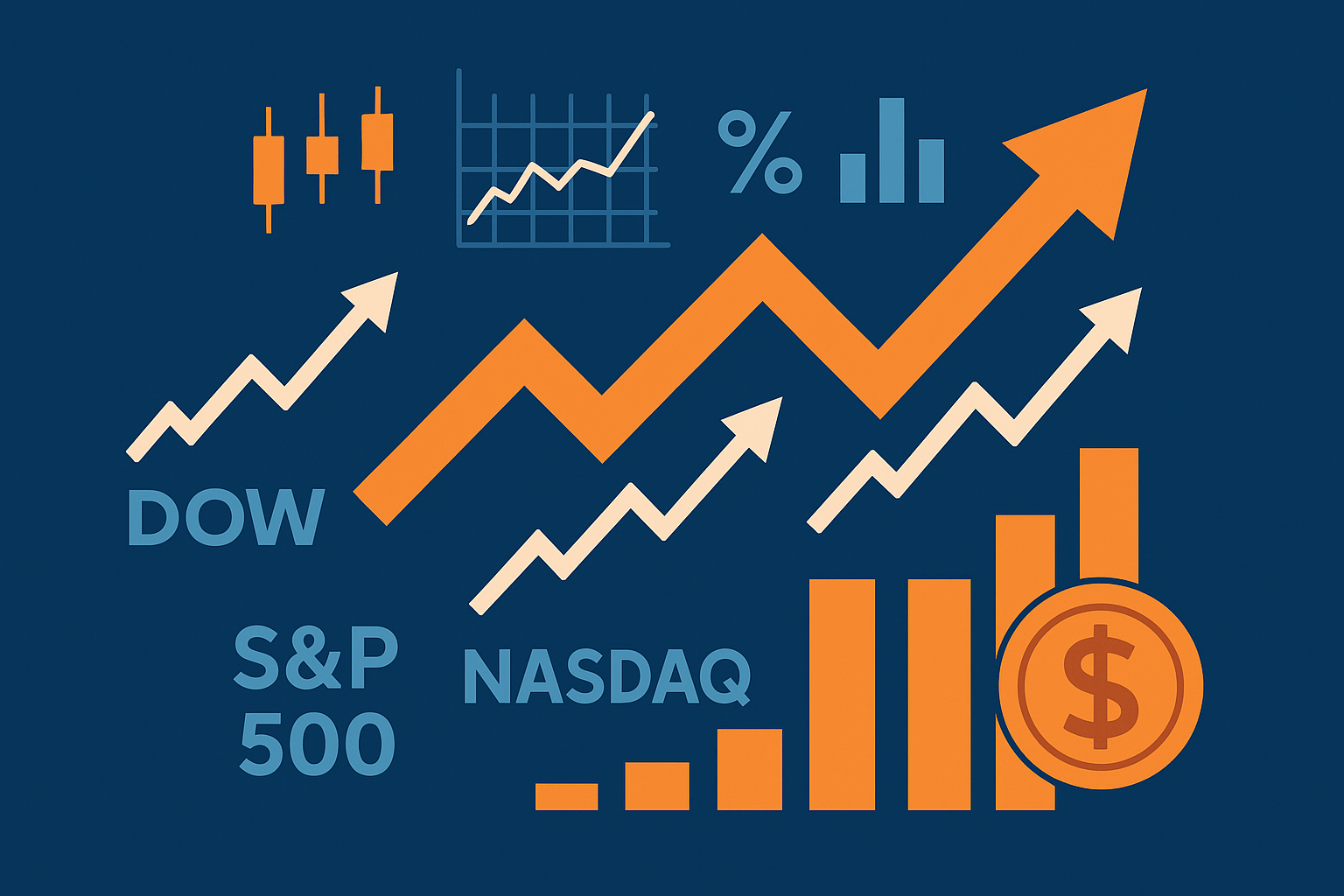
Stock market futures started the week with gains on Monday. The Dow Jones Industrial Average futures increased by 0.5%, while the S&P 500 futures rose by roughly the same margin. The Nasdaq 100 futures, which focus heavily on technology stocks, advanced by 0.7%. This movement sets major indexes on course to finish the volatile first half of 2025 positively. Encouraging signals from international trade negotiations and reduced anxiety over tariffs helped fuel this momentum.
Dow Jones Industrial Average and Key Futures Rally as Trade Optimism Builds
The Dow Jones Industrial Average and related dow jones futures have reacted favorably to signs of progress in trade talks after several months of tariff-related market turbulence. Canada’s recent decision to drop its digital services tax on U.S. technology companies removed a notable obstacle. This policy reversal came shortly before the tax was scheduled for enforcement, calming markets rattled by earlier disruptions in talks caused by this dispute.
Similarly, stock futures tied to the s&p 500 today and nasdaq composite gained from reports that the Trump administration and China are closer to proposing a trade framework, which sharpens hopes for easing long-standing tensions. Additionally, India’s extension of its visit to Washington for trade discussions highlights a broader move toward reducing barriers in global commerce.
These developments reflect a trend noted in early 2025 where U.S.-China negotiators made tangible progress toward a trade agreement involving tariff reductions and increased access to Chinese markets for U.S. goods, as Reuters reported on March 15. The postponement of Canada’s digital services tax, confirmed by The Wall Street Journal on April 20, further strengthens the outlook for reduced trade frictions.
S&P 500 and Nasdaq Surge Reflect Growing Market Optimism
Both the S&P 500 and Nasdaq Composite closed at record highs last Friday, marking a significant rebound since the tariff-driven swings earlier this year. These gains underscore how trade developments and tax policies remain primary factors influencing stock market today performance.
Investors focusing on dow jones industrial average today and nasdaq today keep a close eye on major technology stocks such as nasdaq nvda (NVIDIA), nasdaq aapl (Apple), nasdaq msft (Microsoft), and tsla stock price (Tesla). The movements of these stocks often foreshadow broader trends within the Nasdaq 100 and serve as indicators of market sentiment.
With dow futures live and djia live showing steady advances, alongside the dow jones industrial average live sentiment trending bullish, many analysts predict the upward trend could persist unless unexpected global events intervene. Bloomberg highlighted on May 10 that global stock markets, including U.S. indices, have benefited from reduced uncertainty tied to ongoing trade negotiations, with the MSCI World Index gaining 2.5% in the first quarter of the year.
Trade Negotiations and Upcoming Tariff Deadlines Influence Market Direction
The political calendar remains filled with critical trade deadlines that may affect this market rally. President Trump has announced no intention to prolong unilateral tariffs past the July 9 deadline, a statement that lifted equity indexes including dow jones futures today. Still, the potential for renewed tariff concerns casts a shadow over market confidence.
The removal of Canada’s digital tax stands as a key milestone impacting djia futures and dow jones industrial futures, given Canada’s role as a significant trade partner. Similarly, ongoing talks with China and India suggest a thaw in tensions, encouraging near-term optimism observed in stock futures cnbc and comparable market indicators.
Senate Tax Negotiations Add Volatility to Stock Market Trading
Domestic policy also shapes the stock market’s outlook. The U.S. Senate is engaged in debates over a $4.5 trillion tax cut proposal brought forth by the Trump administration. While aimed at stimulating growth, this bill faces criticism for potentially increasing the deficit by $3.3 trillion over ten years, as the Congressional Budget Office reports. Upcoming votes create uncertainty for investors.
Republican leaders seek to convince hesitant members to pass the legislation, an outcome that would influence stock market stocks through changes to corporate taxes, consumer spending, and economic forecasts. Observers of dow jones index futures and s&p 500 index today track these developments carefully given their potential to impact investor choices.
Historical Context: Comparing 2025 Market Moves with Prior Cycles
Trade disputes and tariff-related tensions have historically triggered volatility in the stock market today. For example, the 2008 downturn featured similar geopolitical and fiscal uncertainty. The dow jones industrial average chart for 2025 shows a comparatively stronger base, supported by improved corporate earnings and efforts toward global economic recovery.
Technology stocks in the nasdaq qqq index continue to exhibit resilience, reflecting growth in sectors like cloud computing, artificial intelligence, and semiconductors. This contrasts with past recessions where industrial shares in the dow jones industrial index suffered greater declines. Comparisons between djia chart today and Nasdaq performance reveal how tech innovation supports market leadership while industries stabilize gradually.
Key Market Statistics and Technical Indicators
| Index / Stock | Performance (%) | Notable Mentions |
|---|---|---|
| Dow Jones Industrial Average | +0.5 (futures) | DJIA futures, Dow Jones live updates |
| S&P 500 | +0.5 (futures) | S&P 500 today, s&p 500 futures live |
| Nasdaq 100 | +0.7 (futures) | Nasdaq composite, nasdaq qqq, nasdaq amzn, nasdaq aapl |
| Individual Tech Stocks | Varied | NVDA, MSFT, TSLA stock price, GOOG stock price, AMZN, AAPL |
Market Outlook and Investor Sentiment
Investor confidence is gaining amid rising dow jones industrial average futures and stock market futures today, underpinned by hopes for trade détente. Market analysts note risk remains if tariff talks falter or if domestic policy shifts provoke new uncertainty.
Traders following nasdaq futures live and djia futures cnbc should monitor support levels on charts such as dow jones index chart and nasdaq index today. The interaction between economic data, trade outcomes, and tax legislation will influence the near-term trajectory of the stock market.
A June 2025 survey from the Economic Policy Institute found that 68% of investors expect that resolving trade disputes will boost economic growth during the second half of this year, reflecting rising optimism underpinning recent market gains.
Important Dates and Market Hours
Traders are reminded that this week features shortened trading hours. Markets will close early at 1 p.m. on Thursday ahead of the Fourth of July holiday and will remain closed on Friday. Such holiday-shortened weeks typically see lighter volumes, which may increase price fluctuations in dow jones industrial average today now and nasdaq today.
Summary Table of Key Terms and Trends
- Dow and Jones Index: Showing steady gains in Dow futures and industrial averages.
- S P500: Climbing to new highs fueled by trade deal optimism.
- Stock Market Today: Maintaining cautious optimism as tariff risks recede.
- Nasdaq NVDA, TSLA: Key technology stocks driving Nasdaq advances.
- Dow Jones Industrial Futures: Outlook contingent on Senate tax votes and trade progress.
- Dow Futures Now: Reflecting positive investor sentiment.
About the Authors: Rian Howlett and Karen Friar offer detailed market analysis with a focus on the US stock market and international trade developments influencing investor decisions.
What This Means for Investors
For both retail and institutional investors, the convergence of improving trade relations and movements on tax policy create a somewhat hopeful investment landscape. Engaging with indices like dow jones industrial average today now and stock market futures can provide useful timing signals for market entry and exit. Staying informed through djia futures now and nasdaq futures live, alongside understanding the broader economic and political context, remains essential for navigating ongoing market volatility.

















